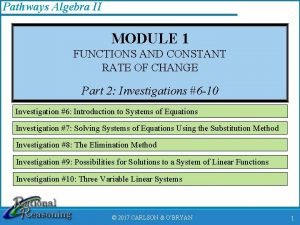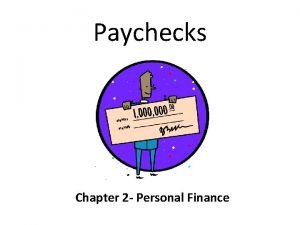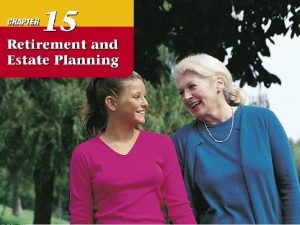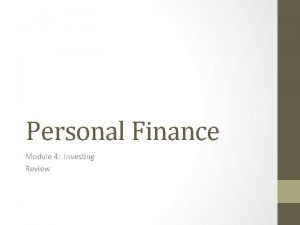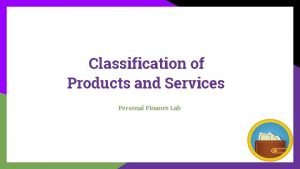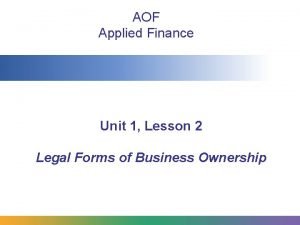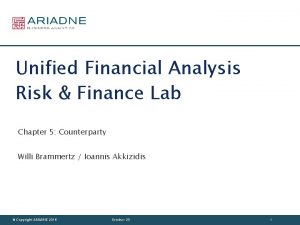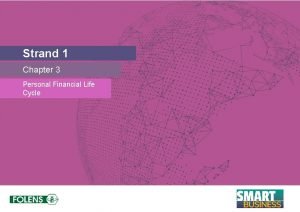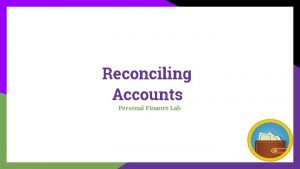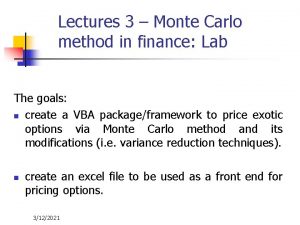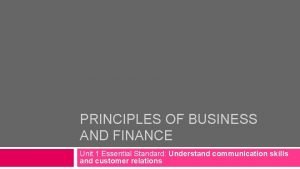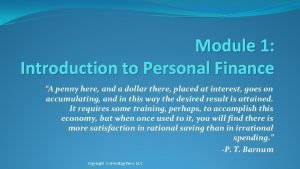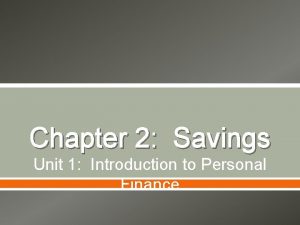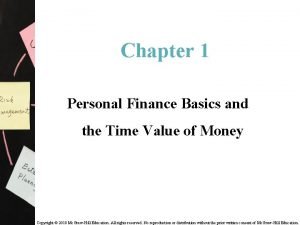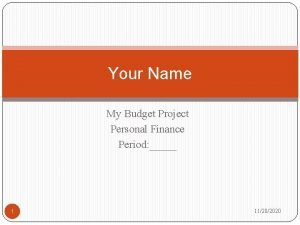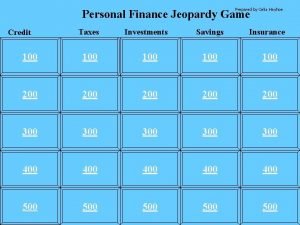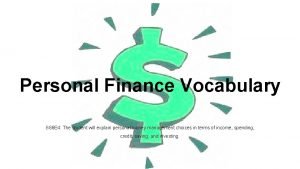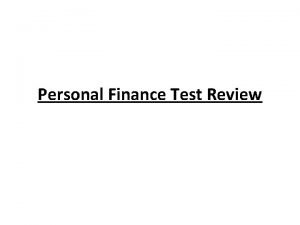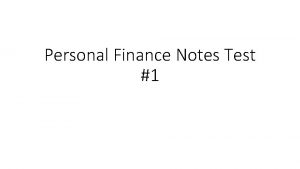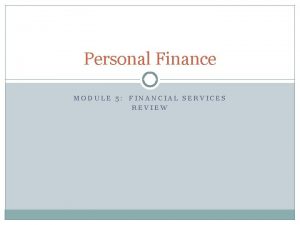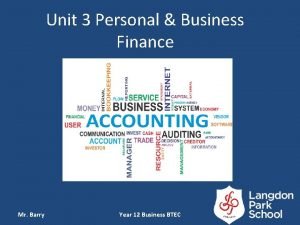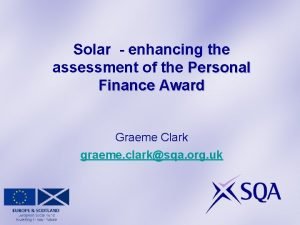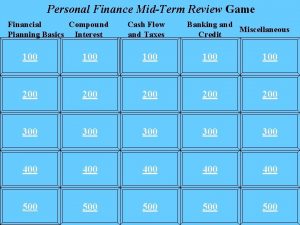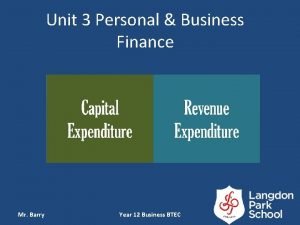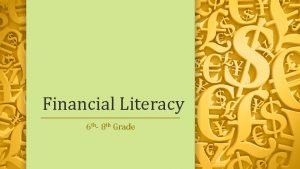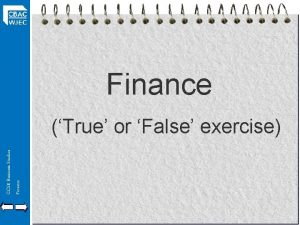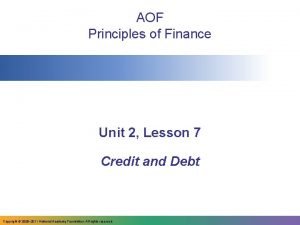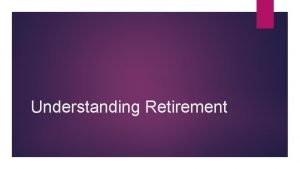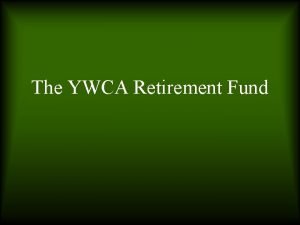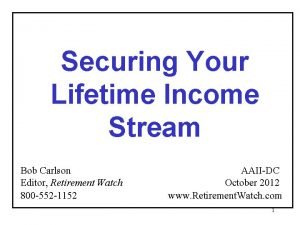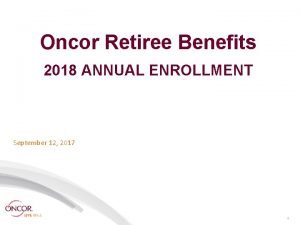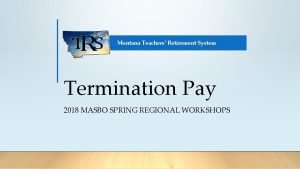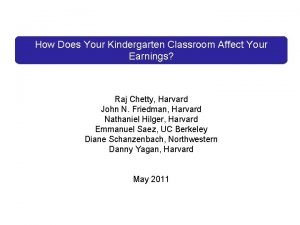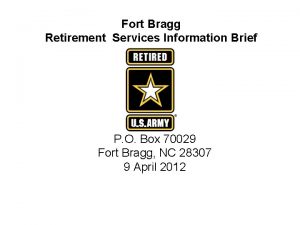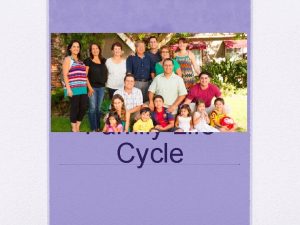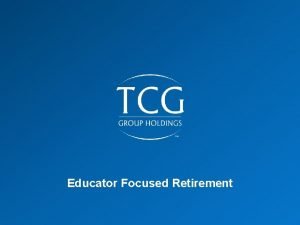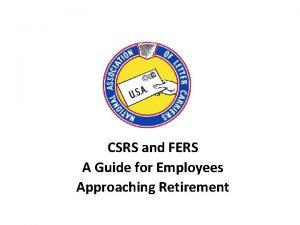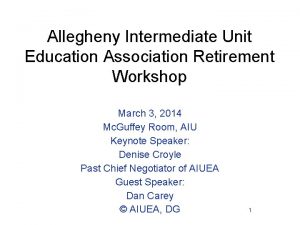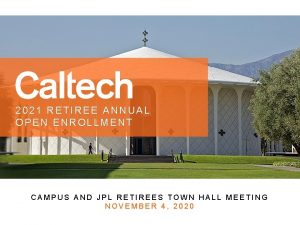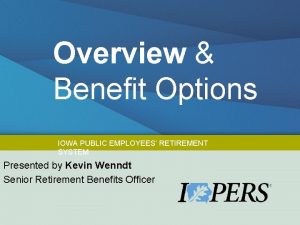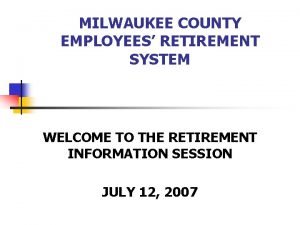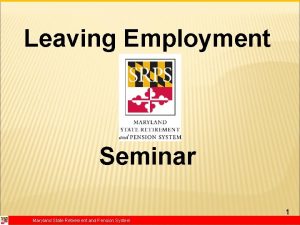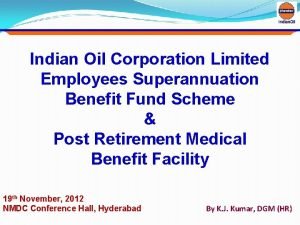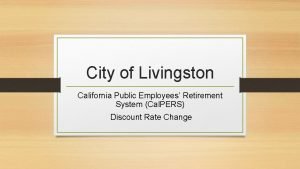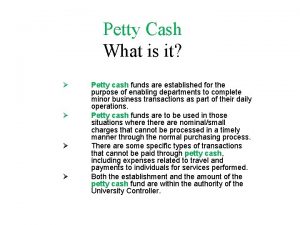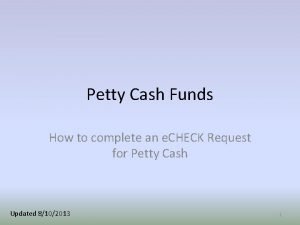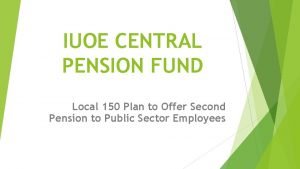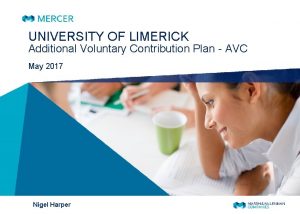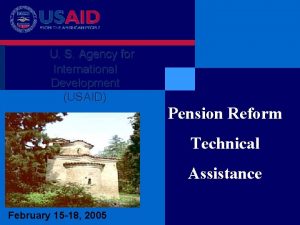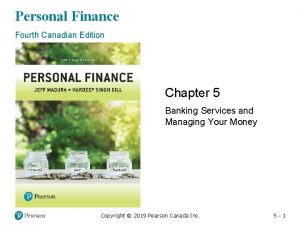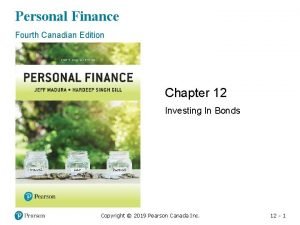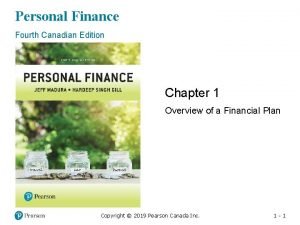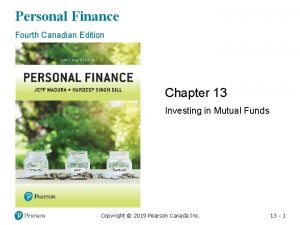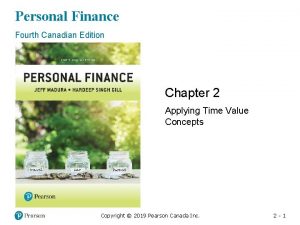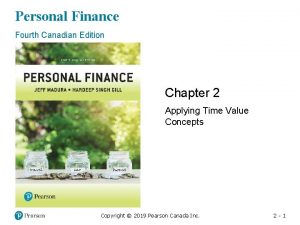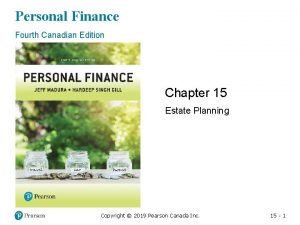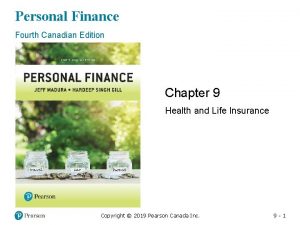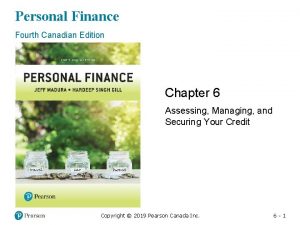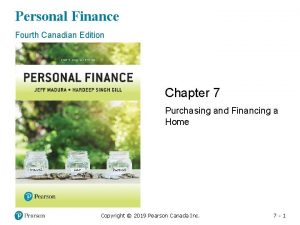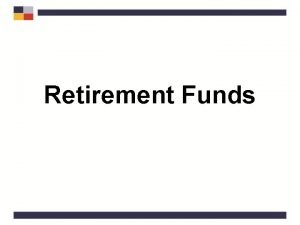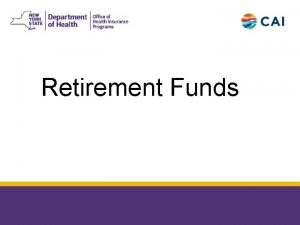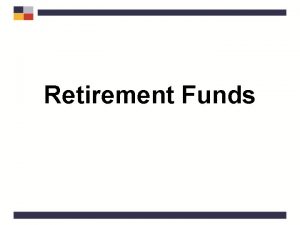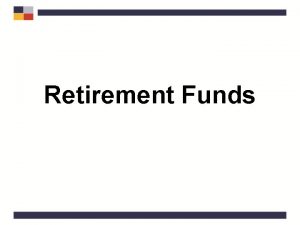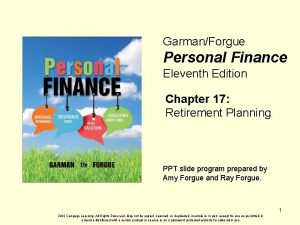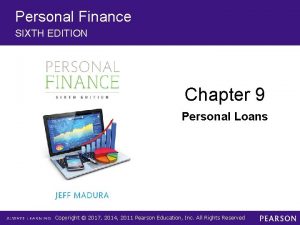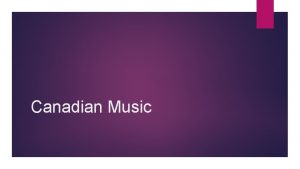Personal Finance Fourth Canadian Edition Chapter 14 Retirement







































































































- Slides: 103

Personal Finance Fourth Canadian Edition Chapter 14 Retirement Planning Copyright © 2019 Pearson Canada Inc. 14 - 1

• • Pension deduction is the biggest deduction The core of financial planning is retirement planning Copyright © 2019 Pearson Canada Inc. 14 - 2

Chapter Objectives (1 of 2) • Describe the role of Old Age Security • Describe the role of the Canada Pension Plan • Explain the difference between defined-benefit and defined-contribution retirement plans • Describe types of individual retirement savings plans • The above are four layers of retirement incomes Copyright © 2019 Pearson Canada Inc. 14 - 3

Chapter Objectives (2 of 2) • Describe types of retirement income conversion options • Present the key decisions you must make regarding retirement plans • Illustrate how to estimate the savings you will have in your retirement account at the time you retire Copyright © 2019 Pearson Canada Inc. 14 - 4

Old Age Security (OAS) Program (1 of 2) • Federal program, from general tax revenues • Criteria are age and residency requirements – lived in Canada at least 40 years since turning age 18, you will receive the full OAS pension – partial pension if lived in Canada fewer than 40 years but more than 10 years since age 18 • Age of eligibility now 65, will gradually rise to 67 • Benefits may be deferred to up to age 70 with increase of 0. 6% per month that you defer your payment Copyright © 2019 Pearson Canada Inc. 14 - 5

Old Age Security (OAS) Program (2 of 2) • Maximum monthly OAS pension for the period April 2017 to June 2017 was $578. 53 • OAS Clawback – OAS benefits are subject to a “means test” – If your income exceeds a certain amount, the benefits you will receive from the OAS program will be reduced – In 2017, the OAS pension was reduced by $0. 15 for every dollar of net income above $74 788, at $119 615, full repayment required Copyright © 2019 Pearson Canada Inc. 14 - 6

Calculation • (119615 -74788)*0. 15/12 = 560. 33 • This is roughly equal to but smaller than 578. 53. • Probably maximum OAS pension payment is adjusted every quarter. Copyright © 2019 Pearson Canada Inc. 14 - 7

Old Age Security Benefit Payment Rates Exhibit 14. 1 Old Age Security Benefit Payment Rates (April–June 2017) Recipient Maximum Monthly Benefit Maximum Annual Income OAS Pension All recipients $578. 53 See OAS Clawback GIS Single person $864. 09 $17 544 Blank Spouse of pensioner $520. 17 $23 184 Blank Spouse of non-pensioner $864. 09 $42 048 Blank Spouse of allowance recipient $520. 17 $42 048 Allowance All recipients $1098. 70 $32 448 Allowance for the survivor All recipients $1309. 67 $23 616 Type of Benefit Source: Data from Government of Canada, “Old Age Security Payment Amounts, ” https: //www. canada. ca/en/services/benefits/publicpensions/cpp/old-age-security/payments. html (accessed May 25, 2017). Copyright © 2019 Pearson Canada Inc. 14 - 8

Guaranteed Income Supplement (GIS) • Payable to a single, divorced, or widowed pensioner who is at least 65 years of age and whose sole source of income is the OAS pension • 2017 max is $864. 09 monthly, or $520. 17 if married and both spouses getting OAS • If a pensioner receives any income other than the OAS pension, the GIS benefit is reduced by $0. 50 for every $1 of additional income Copyright © 2019 Pearson Canada Inc. 14 - 9

OAS GIS Example Martha is a 66 -year-old OAS pensioner married to Fred, who is a 65 -year-old OAS pensioner. Both of them were born and raised in Canada. They have no other sources of income besides their respective OAS pensions. Martha’s total income for the month would be $1098. 70 ($578. 53 + $520. 17). Similarly, Fred’s total income for the month would be $1098. 70. As a result, their combined annual income from OAS and GIS would be $26 368. 80 (calculated as [$1098. 70× 12]× 2). The maximum annual income column in Exhibit 14. 1 indicates that if either Martha or Fred has annual income other than OAS pension that is greater than $23 616, she or he would not be eligible to receive the GIS. This maximum annual income figure applies to each of them individually (combined income, not individually). Copyright © 2019 Pearson Canada Inc. 14 - 10

Some calculations • For a single person, if GIS is reduced by $0. 50 for every $1 of additional income, the level of annual income without GIS would be • 864. 09*2*12 = 20738 • This is higher than 17544 in the book. • For a married couple, the level of annual income without GIS would be • 520. 17*2*12 = 12484 • This is much lower than 23184 in the book. • Any mistakes in calculations or understanding? Copyright © 2019 Pearson Canada Inc. 14 - 11

Mistake in the book and notes • In the book and in the notes, which I have changed, annual income figure applies to each of them individually. • Check the website • https: //www. canada. ca/en/services/benefits/public pensions/cpp/old-age-security/payments. html • It refers to combined income. • Numbers still don’t match exactly. Payments adjust quarterly. We can’t expect exact match. Copyright © 2019 Pearson Canada Inc. 14 - 12

Old Age Security • Allowance Benefit (for spouse or common-law partner between age 60 and 64 whose spouse is receiving, or is eligible to receive, OAS and GIS) • Allowance for the Survivor Benefit, aged 60 -64 • Must apply for benefits • Inflation Protection • OAS is taxable benefit, GIS, allowance, and allowance for the survivor benefit are tax-free Copyright © 2019 Pearson Canada Inc. 14 - 13

Canada Pension Plan (CPP) Program • A contributory pension plan program • Benefit based on dollar value of contributions and number of years you contribute • Apply to receive benefits as early as age 60 and as late as age 70, with normal retirement age 65 • Pensioners may benefit from a pension assignment: when a married or common-law couple shares their CPP retirement pensions to reduce income taxes Copyright © 2019 Pearson Canada Inc. 14 - 14

CPP Program (1 of 3) • First $3500 of annual income is exempt from the CPP contribution calculation (your year’s basic exemption (YBE)) • Contribution rate is 9. 9% of your pensionable earnings (amount of income you earn between the year’s basic exemption (YBE) and the year’s maximum pensionable earnings (YMPE)) – 2017 YMPE was $55 300 – CPP contribution rate is split between employees and their employers (4. 95% each) – Self-employed individuals must contribute 9. 9% Copyright © 2019 Pearson Canada Inc. 14 - 15

CPP Example Colleen works as an employee for Dynamex Industries. During 2017, she earned income of $60 000. Her spouse, Chris, is a self-employed carpenter. His earned income in 2017 was $38 000. Colleen’s CPP contribution amount would be calculated as follows: (The lesser of Annual Income or YMPE − YBE) × 4. 95% = ($55 300 − $3500) × 4. 95% = $2564. 10 Chris’s CPP contribution amount would be calculated as follows: (The lesser of Annual Income or YMPE − YBE) × 9. 9% = ($38 000 − $3500) × 9. 9% = $3415. 50 Copyright © 2019 Pearson Canada Inc. 14 - 16

CPP Program (2 of 3) • Investment decisions made by the CPP Investment Board • CPP Benefit Amount- some exclusions apply • Must apply to receive CPP benefits, 2017 max was $1114. 17 monthly • You may apply early or delay benefits – In 2017, between ages 60 and 65, benefits are reduced by 0. 60 % for every month early – In 2017, between ages 65 and 70, benefits are increase by 0. 7 % for every month late Copyright © 2019 Pearson Canada Inc. 14 - 17

CPP Program (3 of 3) • Inflation Protection (adjusted every January) • CPP retirement pension is a taxable benefit • Employee contributions can be claimed as a nonrefundable tax credit • Employer contributions are a deductible business expense • Self-employed individuals can claim both the tax credit and the expense deduction Copyright © 2019 Pearson Canada Inc. 14 - 18

Early CPP Example (1 of 2) Mark has decided to apply for early CPP benefit, Janet will apply for CPP at the normal retirement age, and Bob will apply for CPP at age 70. The annual CPP benefit amount is calculated using the 2017 maximum monthly CPP retirement pension of $1114. 17. Inflation is assumed to be 2 percent per year. Exhibit 14. 2 illustrates that Janet will receive an annual CPP benefit of $13 370 when she turns age 65. This represents 100 percent of the amount she is eligible for, calculated as $1114. 17 × 12 = $13 370. Notice that Mark receives less than this amount ($8557) and that Bob receives more than this amount ($18 985). As mentioned earlier, in 2017, benefits are reduced by 0. 60 percent for every month that you take benefits early and are increased by 0. 70 percent for every month that you take benefits late, up to age 70. Mark is taking his CPP at age 60, which is 60 months earlier than the normal retirement age of 65. As a result, his CPP benefit is reduced by 36 percent, calculated as 0. 60 × 60 months. Bob is taking his CPP at age 70, which is 60 months later than the normal retirement age of 65. As a result, his CPP benefit is increased by 42 percent, calculated as 0. 7 × 60 months. Copyright © 2019 Pearson Canada Inc. 14 - 19

Early CPP Example (2 of 2) Exhibit 14. 2 shows that even though Janet and Bob start receiving CPP benefits later than Mark, the total CPP retirement pension received by Janet and Bob will eventually be greater than the amount received by Mark. In Janet’s case, her total CPP benefit will exceed that of Mark by age 75. Bob will exceed Mark’s total CPP benefit by age 80, and he will pass Janet by age 84. The amount of CPP you will collect over a period of time should not be the only consideration as to when you apply for CPP benefits. Exhibit 14. 2 implies that Mark, Janet, and Bob will each live until at least age 86. Although this may not be the case, Exhibit 14. 2 does illustrate that if you have other retirement income options, you should carefully consider the timing of your CPP retirement pension application. Copyright © 2019 Pearson Canada Inc. 14 - 20

Time value in consideration • The above discussion does not consider time value. • If time value is considered, one should take CPP as soon as one is retired. Copyright © 2019 Pearson Canada Inc. 14 - 21

CPP Alternatives (1 of 2) Exhibit 14. 2 Accumulated CPP Retirement Pension Blank Mark Janet Bob Early Retirement Normal Retirement Late Retirement 60 $8 557 — — 61 17 285 — — 62 26 187 — — 63 35 268 — — 64 44 530 — — 65 53 978 13 370 — 66 63 614 27 007 — 67 73 443 40 918 — 68 83 469 55 106 — 69 93 695 69 578 — Age Copyright © 2019 Pearson Canada Inc. 14 - 22

CPP Alternatives (2 of 2) Exhibit 14. 2 Continued Blank Mark Janet Bob Early Retirement Normal Retirement Late Retirement 70 104 126 84 340 18 985 71 114 765 99 397 38 351 72 125 617 114 755 58 103 73 136 686 130 420 78 251 74 147 977 146 398 98 801 75 159 493 162 696 119 763 76 171 240 179 320 141 143 77 183 222 196 277 162 952 78 195 443 213 572 185 196 79 207 908 231 214 207 885 Age Copyright © 2019 Pearson Canada Inc. 14 - 23

CPP Alternatives Exhibit 14. 2 Continued Blank Mark Janet Bob Early Retirement Normal Retirement Late Retirement 80 220 623 249 208 231 029 81 233 593 267 562 254 635 82 246 821 286 283 278 713 83 260 315 305 379 303 273 84 274 078 324 857 328 323 85 288 116 344 724 353 875 86 302 435 364 989 379 938 Age Copyright © 2019 Pearson Canada Inc. 14 - 24

The efficiency of government pensions • Many articles talked about the benefit we will receive upon retirement. Few articles talk about how much we have to pay for the potential benefit. We will briefly discuss the cost we pay for retirement. Copyright © 2019 Pearson Canada Inc. 14 - 25

• The easiest part to calculate is CPP (Canada Pension Plan) contribution. For people earning $55, 000 or higher a year, CPP contribution is over $5000, including the employer‘s contribution. • OAS (Old Age Security) benefits come from general tax income. It is not directly connected to your individual tax contribution. As OAS benefits cover everyone and benefit amount is of similar value to CPP, we can estimate our average tax contribution to OAS is at least $5000. Copyright © 2019 Pearson Canada Inc. 14 - 26

• With CPP and OAS, an average person pays about $10, 000 per year for retirement. • Copyright © 2019 Pearson Canada Inc. 14 - 27

estimate the efficiency of government retirement benefit. • Our average CPP and OAS contribution is $10, 000 a year. Over 40 years, our total contribution is $400, 000, assuming time value and inflation adjustment. • Average Canadian life span is 81 years old. On average, we will receive 81 -65 = 16 years benefits. The maximum retirement benefit for a single pensioner from the government is $24000, or $23997 to be precise, in the year 2017. • Copyright © 2019 Pearson Canada Inc. 14 - 28

• But not every one is a single, and majority have other incomes, such as company pensions. The average payout may be much lower than $20, 000. Suppose the average payout is $20, 000. Over 16 years, the total payout is $320000, which is lower than the total contribution of $400, 000. Copyright © 2019 Pearson Canada Inc. 14 - 29

Brief history of CPP Maximum annual Basic total pensionable exemption contribution amount rate (%) year earnings 1966 5000 600 3. 6 1980 13100 1300 3. 6 1990 28900 2800 4. 4 2000 37600 3500 7. 8 2010 47200 3500 9. 9 2020 58700 3500 10. 5 Copyright © 2019 Pearson Canada Inc. 14 - 30

Basic pattern • CPP contribution rate website • https: //www. canada. ca/en/revenueagency/services/tax/businesses/topics/payroll/payr oll-deductions-contributions/canada-pension-plancpp/cpp-contribution-rates-maximumsexemptions. html • The contribution rate has been increasing over time. Copyright © 2019 Pearson Canada Inc. 14 - 31

CPP pension benefit • CPP benefit rate is about 25% of pensionable earning after one is 65. • Will increase to 33% over time. • When? 2065 Copyright © 2019 Pearson Canada Inc. 14 - 32

Calculation of pension benefit (Brief) • CPP contribution starts at age 18, ends at 65 • Can remove 8 years with least income from calculation • Total years as denominator: 65 -18 -8 = 39 • Numerator: the actually number of years of contribution, minus 8 years. Copyright © 2019 Pearson Canada Inc. 14 - 33

Example one • Jason started working since he is 18. He earns 30, 000 every year. He will retire at 65, after working for 47 years. His annual CPP contribution is 30, 000*10% = 3000 dollar. The maximum annual CPP benefit will be 60, 000*25% = 15000 dollar. Jason’ annual CPP benefit will be 15000*(30, 000/60, 000)*(65 -18)/(65 -18) = 7500 dollar. Copyright © 2019 Pearson Canada Inc. 14 - 34

Example 2 • Chris started working since he is 39. He earns 45, 000 dollar every year. He will retire at 65, after working for 26 years. His annual CPP contribution is 45, 000*10% = 4500 dollar. The maximum annual CPP benefit will be 60, 000*25% = 15000 dollar. Chris’ annual CPP payment will be 15000*(45000/60, 000)*(65 -39)/(65 -18 -8) = 7500 dollar. Copyright © 2019 Pearson Canada Inc. 14 - 35

Comments • Jason and Chris’ CPP payments will be the same when they retire. Suppose the annual return from investment of CPP contribution is 1%. What are the values of Jason and Chris’s contributions when they retire at 65? • The actual calculations can be more involved. There are other factors such as years of taking care of babies. Copyright © 2019 Pearson Canada Inc. 14 - 36

Concern about Retirement Benefits in the Future • In 2010, OAS and CPP represented more than 40% of seniors’ total income • A single pensioner receiving 100% OAS and CPP will receive $23 997/year, in 2017 • Will government-sponsored benefits be available to future generations? • What other retirement income options are available to Canadian employees? Copyright © 2019 Pearson Canada Inc. 14 - 37

Calculation of total retirement benefits from the government • Maximum benefit for a single pensioner from the government (OAS + CPP) • (578. 53+864. 09)*12 + 13370*0. 5 = 23997 • Or monthly payment of 2000 dollars • The first part is full OAS+ GIS. The second part is half of full CPP payment. • The average CPP payment in 2018 is 664 dollars per month. Total monthly payment would be • (578. 53+864. 09) + 664*0. 5 = 1774 Copyright © 2019 Pearson Canada Inc. 14 - 38

Retirement income: A comparison with prime time income • The median income of a Canadian household is less than 60, 000 dollar a year. If a family has two children, each person would have less than 15, 000 dollars a year. • If you are from such a family, the retirement income from government alone is higher than your income in your prime time. • There are other sources of retirement income, such as company pensions. Copyright © 2019 Pearson Canada Inc. 14 - 39

Registered Pension Plans Copyright © 2019 Pearson Canada Inc. 14 - 40

Percentage of employees with a registered plan through their jobs Men Women Both 1977 52 36 46 2011 37 40 38 Copyright © 2019 Pearson Canada Inc. 14 - 41

Source of data • A New Premium on Retirement, Globe and Mail, June 21, 2016 • https: //www. theglobeandmail. com/globeinvestor/retirement/cpp-reform-whats-changingand-how-it-will-affectyou/article 30551445/ Copyright © 2019 Pearson Canada Inc. 14 - 42

Observations from the Globe and Mail article, (1 of 2) • How the increase of pension was introduced? – The federal finance department said the portion of earnings between $54, 900 and $82, 700 will have a different contribution rate for workers and employers, expected to be set at 4 per cent. – That is not the case. The contribution rate turns out to be the same in later years. – The statement was made in 2016. In 2017, the contribution rate for higher portion was the same. If the government could not keep the promise made less than one year ago, how likely it will keep the promises made decades ago? Copyright © 2019 Pearson Canada Inc. 14 - 43

Observations from the Globe and Mail article, (2 of 2) • The language of benefit and cost – Benefit is called benefit – Cost is not called cost in the article. It is called funding. The title of the section is How will higher benefits be funded. Copyright © 2019 Pearson Canada Inc. 14 - 44

Employer-Sponsored Retirement Plans • Defined-Benefit Pension Plans – Employer-sponsored retirement plan, guarantees a specific amount of income when you retire, based on salary and years of employment, risk on employer – May be contributory or non-contributory – Employer contributions based on actuarial values and assumptions – Actuary reassesses the plan every three years – Employer must make at least 50% of the contributions Copyright © 2019 Pearson Canada Inc. 14 - 45

Defined Benefit Pension Plans (1 of 2) • At retirement, an employee will receive a pension benefit based on a specific formula – Flat benefit plan (fixed amount based on years of service, lower amount than unit benefit) – Unit benefit plan (considers earnings and years of service) § Three types: final average, best average, career average Copyright © 2019 Pearson Canada Inc. 14 - 46

Defined Benefit Plan Example Bridgette is retiring after 30 years of employment with Barney, Smith, and Caulfield. Her employer-sponsored defined-benefit pension plan uses a best average earnings calculation to determine her benefit amount. For each year of service, Bridgette earns an annual pension income of 1. 5 percent of her best average earnings. To calculate Bridgette’s pension income, her best three consecutive years of income are taken into account. Bridgette’s best earnings years occurred at the end of her career. The table below displays her income for the last five years of her career. Blank Annual Earnings 2013 2014 2015 2016 2017 $55 000 $70 000 $90 000 $100 000 $65 000 Bridgette’s best earnings years were 2014, 2015, and 2016. Her average earnings for this period were $86 667, calculated as ($70 000 + $90 000 + $100 000) ÷ 3. Her annual pension income will be $86 667 × 0. 015 × 30 = $39 000. Copyright © 2019 Pearson Canada Inc. 14 - 47

Defined Benefit Pension Plans (2 of 2) • Vested: a claim to money reserved for you upon retirement, even if you leave – Contributions must vest no later than two years after the employee becomes a plan member and must be used to provide retirement income • Vested benefits may be: – Left in your former employer’s pension account, – Transferred to your new employer, or – Transferred to an individual locked-in retirement account (LIRA) • Similar to the Canada Pension Plan • Taxable benefit; employer contributions are a deductible business expense Copyright © 2019 Pearson Canada Inc. 14 - 48

Defined-Contribution Pension Plans (1 of 2) • An employer-sponsored retirement plan where the contribution rate, not the benefit amount, is based on a specific formula • Plan may be contributory or non-contributory • Pension benefits are determined by the return on investment and the contributions accumulated each year, risk on employee • Flexibility to postpone savings for retirement (a disadvantage) Copyright © 2019 Pearson Canada Inc. 14 - 49

Defined-Contribution Pension Plans (2 of 2) • In a money purchase plan, contributions are: – A fixed percentage of employee earnings, or – A fixed dollar amount, or – A specified number of cents per year of service or per hour worked • In a profit sharing pension plan, contributions by the employer are a proportion of the firm’s profits, with a defined minimum rate equal to 1 percent of employee earnings, regardless of whether a profit has been realized (not popular) Copyright © 2019 Pearson Canada Inc. 14 - 50

Benefits of a Defined-Contribution Pension Plan • Extra income above and beyond your salary • Encourages you to save each pay period • Contributions are tax deductible • Income generated taxed when you withdraw money after you retire • At retirement, likely in a lower tax bracket Copyright © 2019 Pearson Canada Inc. 14 - 51

Defined-Contribution Pension Plan • Investing Funds in Your Retirement Account – Can select from a variety of mutual funds • Pension Adjustment – calculates the remaining annual contribution room available to an individual after taking into account any employer-sponsored pension plan contributions – Applies to DB and DC pensions Copyright © 2019 Pearson Canada Inc. 14 - 52

Receiving Retirement Income from Your Employer-Sponsored Retirement Plan • Normal retirement age: the age by which employees are entitled to receive 100% of the pension income they are eligible for – In many plans, the normal retirement age is 65 – Some plans use combo of age and years of service • In the event of the employee’s premature death, a reduced pension is often paid to a surviving spouse Copyright © 2019 Pearson Canada Inc. 14 - 53

Receiving Retirement Income • Options with respect to pension income: – Paid as a single life income or as a joint-and-survivor life income – In most cases, a retiring employee can choose a pension guarantee that will provide a pension income for a certain number of years § Employee dies before the end of the guaranteed period, any remaining pension payable will be paid to a named beneficiary or to the employee’s estate – Defined-contribution pension plans tend to be more flexible options Copyright © 2019 Pearson Canada Inc. 14 - 54

Pension Splitting • Allows income eligible for the pension income tax credit to be split with a spouse or common-law partner • Types of income that can be split: – Pension from a registered pension plan (RPP) – Income from an RRSP annuity – Income from a registered retirement income fund (RRIF) Copyright © 2019 Pearson Canada Inc. 14 - 55

Pension Splitting Example Dominic, age 65, has been a member of a defined-benefit pension plan for the past 35 years. Now that he has reached normal retirement age, Dominic would like to receive his regular pension income. His employer calculates his pension benefit to be $3000 per month. In addition, if Dominic dies before his spouse, Lisette, she will receive 60 percent of the pension that Dominic was receiving. Prior to 2010, Dominic’s pension benefit of $36 000 per year would have been recorded as his pension income and taxed accordingly. Under the new guidelines for the taxation of pension income, half of the pension income received by Dominic may be deducted from his tax return and included on Lisette’s tax return. Assuming that they have no other income, Dominic and Lisette will each pay tax based on an annual income of $18 000. Copyright © 2019 Pearson Canada Inc. 14 - 56

Registered Retirement Savings Plans (RRSPs) • A private pension that enables you to save for your retirement on a tax-deferred basis • Contributions are tax deductible • Income earned on your investments is not taxed until you withdraw money at retirement • Any Canadian citizen aged 71 years or younger with an earned income can contribute • Any withdrawal is subject to income tax Copyright © 2019 Pearson Canada Inc. 14 - 57

RRSP Account Types • Individual RRSP – Money invested in investment instruments offered where you opened the account • Self-directed RRSP – Variety of investments within one plan (mutual funds, stocks, bonds) – More costly to administer • Group RRSP – Series of individual RRSPs administered through one employer/association – Alternative to employer-sponsored pension plans – Employer contributions not required Copyright © 2019 Pearson Canada Inc. 14 - 58

RRSP Qualified Investments • Cash, GICs, and other short-term deposits • Individual stocks and bonds that are listed on an exchange • Mutual and index funds • Annuities • Warrants, rights, and options • Royalty and limited partnership units • Mortgages (under specific circumstances) • Investment-grade bullion, coins, bars, and certificates Copyright © 2019 Pearson Canada Inc. 14 - 59

How Much Can I Contribute? • Maximum RRSP contribution limit for 2017 was $26 010 • To determine the specific limit that applies for 2017, multiply your 2016 income by 18 percent • If you are, or were, a member of an employersponsored pension plan, you must take into account your pension adjustment • If you contribute less than your RRSP contribution limit, you can carry forward the balance and contribute this amount in future years • Can contribute up to year you turn age 71 Copyright © 2019 Pearson Canada Inc. 14 - 60

Spousal RRSPs • A type of RRSP where one spouse contributes and the other is the beneficiary • Advantages: – Allows the higher income spouse to receive a tax deduction for contributions – Provide a useful income-splitting tool – A spouse who has passed age 71 can still contribute to a spousal RRSP for his or her younger spouse Copyright © 2019 Pearson Canada Inc. 14 - 61

Spousal RRSP Example Pasquale is a 40 -year-old self-employed accountant. His 2016 earned income was $150 000. Based on this income, Pasquale is eligible to contribute $26 010 to his RRSP in 2017. Pasquale’s spouse, Roberta, is a 35 -year-old stay-at-home mom. Prior to 2016, Roberta also worked as an accountant for a public firm. After the birth of their second child, the couple decided that Roberta should stay at home until this youngest child starts kindergarten. At present, they each have $200 000 in their RRSP plans, and neither of them has any carry-forward room. To maintain similar-sized retirement plans, Pasquale has decided to open a spousal RRSP. He will split his 2017 contribution in half by contributing $13 005 to his personal RRSP and $13 005 to a spousal RRSP. Once he has completed this transaction, Pasquale will have $213 005 in his RRSP plan while Roberta will have $200 000 in her RRSP plan, plus an additional $13 005 in a spousal RRSP. As a result of these transactions, Pasquale will have a $26 010 tax deduction and the couple will maintain RRSP accounts of similar size. They will continue to use this strategy until Roberta returns to the workforce. In the year that Pasquale turns age 72, he will still be able to make spousal RRSP contributions since Roberta will only be 67 years old. Copyright © 2019 Pearson Canada Inc. 14 - 62

Tax-Free Withdrawals from an RRSP (1 of 2) • Home Buyers’ Plan (HBP): a tax-free RRSP withdrawal that is available to Canadians who would like to buy their first home – First-time home buyer : you or your spouse or common -law partner have not owned a home as a principal residence in the four years preceding the year of withdrawal – Maximum withdrawal is $25 000 – Withdrawal must be paid back into the RRSP over a 15 -year period Copyright © 2019 Pearson Canada Inc. 14 - 63

Tax-Free Withdrawals from an RRSP (2 of 2) • Lifelong learning plan (LLP): a tax-free RRSP withdrawal for full-time students to temporarily finance their education – Withdrawal can be made form an RRSP owned by you or your spouse or common-law partner – Max annual withdrawal is $10 000; Max is $20 000 – Must be paid back into the RRSP over a 10 -year period, payments start the fifth year after your first withdrawal – Funds withdrawn from an RRSP will no longer be earning tax-sheltered income • CAUTION: HBP and LLP withdrawals have long term impacts Copyright © 2019 Pearson Canada Inc. 14 - 64

Tax-Free Savings Account (TFSAs) • Buy with after tax dollars • No income requirement • Any Canadian resident age 18 or older is eligible to open a TFSA account • Current annual contribution limit is $5500 – Increases once the cumulative annual effect of inflation justifies a $500 incremental increase – Unused contributions can be carried forward Copyright © 2019 Pearson Canada Inc. 14 - 65

TFSAs • Contribution are not tax deductible • Withdrawals are tax-free and can be recontributed the following year • Can hold account until you die • Can be used for short-term as well as long-term goals • TFSA Account Types: – High-interest savings accounts, term deposits, GICs, mutual fund, self-directed, and group TFSAs Copyright © 2019 Pearson Canada Inc. 14 - 66

Comparison of RRSPs and TFSAs (1 of 2) Exhibit 14. 4 Comparison of RRSPs and TFSAs Blank RRSP TFSA Eligibility Canadian citizens aged 71 or younger with an earned income Canadian residents aged 18 or older Primary Purpose Retirement income Short- and long-term savings Annual Contribution Limit 18% of earned income, up to a maximum of $26 010 in 2017; indexed thereafter (pension adjustment may apply) $5500 in 2017; indexed thereafter ($500 increments) Unused Contribution Carry Forward Yes Tax Deductible Contributions Yes No Tax-Deferred Savings Yes Copyright © 2019 Pearson Canada Inc. 14 - 67

Comparison of RRSPs and TFSAs (2 of 2) Exhibit 14. 4 Continued Blank RRSP TFSA Withdrawals are Taxable Yes, considered earned income No, not considered earned income Withdrawal Recontribution No, unless part of HBP or LLP Yes, the following year Withholding Tax Yes Not applicable Plan Termination Plan must be converted or collapsed in the year you turn age 71 Not applicable Qualified Investments Blank Cash, GICS, other short-term deposits, stocks, bonds, mutual and index funds, annuities, warrants, right, options, royalty and limited partnership units, mortgages, investment-grade bullion, coins, bars, and certificates Copyright © 2019 Pearson Canada Inc. 14 - 68

TFSA Example Jordan turned 18 on January 17, 2016. In January 2016, Jordan opened a TFSA account and deposited the maximum annual contribution limit of $5500. In December 2016, he decided to withdraw $4000, tax-free, to cover travel expenses for a Caribbean vacation and to pay for Christmas presents for friends and family. Jordan’s contribution limit for the following year, 2017, is $5500. However, he will also be able to recontribute the $4000 he withdrew in December 2016. As a result, Jordan has an available 2017 contribution room of $9500. If he decides not to make any contributions in 2017, Jordan carry forward his $9500 of contribution room to 2018. Copyright © 2019 Pearson Canada Inc. 14 - 69

Locked-in Retirement Accounts (LIRAs) • A private pension plan created when an individual transfers vested money from an employer-sponsored pension plan • Main purpose is to provide an opportunity for employees who leave a company pension plan to take the value of their pension plan with them • Can be established as an individual LIRA or as a selfdirected LIRA • Can’t make regular contributions • Funds can’t be withdrawn at will, must be used to provide retirement income Copyright © 2019 Pearson Canada Inc. 14 - 70

Retirement Income Conversion Options for RRSPs and TFSAs • By the end of the year in which you turn age 71, must cash in your RRSP or transfer into an incomeproducing plan • Fully taxable when cashed in, common to transfer all RRSP assets into a RRIF to defer tax • Do not have to sell assets when transferring • Risk that assets that may decrease in value • Percentage of assets held in RRIF must be taken into income each year (prescribed factors) • TFSA assets cannot be transferred into an RRIF Copyright © 2019 Pearson Canada Inc. 14 - 71

RRIF Prescribed Factors (1 of 2) Exhibit 14. 5 CRA Prescribed Factors Expressed as Percentages of the January 1 RRIF Value Age of RRIF owner or spouse or common-law partner at January 1 RRIF Factor 63 0. 037037 74 0. 0567 85 0. 0851 64 0. 038462 75 0. 0582 86 0. 0899 65 0. 040000 76 0. 0598 87 0. 0955 66 0. 041667 77 0. 0617 88 0. 1021 67 0. 043478 78 0. 0636 89 0. 1099 Copyright © 2019 Pearson Canada Inc. 14 - 72

RRIF Prescribed Factors (2 of 2) Exhibit 14. 5 Continued Age of RRIF owner or spouse or common-law partner at January 1 RRIF Factor 68 0. 045455 79 0. 0658 90 0. 1192 69 0. 047619 80 0. 0682 91 0. 1306 70 0. 050000 81 0. 0708 92 0. 1449 71 0. 0528 82 0. 0738 93 0. 1634 72 0. 0540 83 0. 0771 94 0. 1879 73 0. 0553 84 0. 0808 95 or older 0. 2000 Source: http: //www. taxtips. ca/rrsp/rrif-minimum-withdrawal-factors. htm. Reproduced with the permission of Tax. Tips. ca. (Accessed May 29, 2017). Copyright © 2019 Pearson Canada Inc. 14 - 73

RRIF Example Vicky Zhao turns 71 in 2017. Before the end of the year, she must either collapse her RRSP for its cash value or transfer her RRSP assets into an income-producing plan. Vicky decides to transfer her RRSP to an RRIF on November 15, 2017. As a result of this transfer, Vicky must make a withdrawal from her RRIF before December 31, 2018. The amount that must be withdrawn from an RRIF is prescribed by the CRA in an RRIF table. Exhibit 14. 5 shows an RRIF table highlighting the minimum amount that must be withdrawn. Assuming that Vicky is age 71 on January 1, 2017, she will have to withdraw 5. 28 percent of her nonqualifying RRIF assets during 2018. The amount that she has to withdraw will be based on the value of her RRIF assets on January 1. The RRIF table represents only minimum withdrawal amounts. Vicky has the option to cash in her RRIF at any time. Copyright © 2019 Pearson Canada Inc. 14 - 74

RRSP Conversion Options • Also consider an annuity: – Term annuity: a financial contract that provides a fixed sum of money at regular intervals until a specified year – Life annuity: a financial contract that provides a fixed sum of money at regular intervals for one’s lifetime – Registered annuities: annuities that are created using assets from an RRSP with no risk that your investment decreases in value Copyright © 2019 Pearson Canada Inc. 14 - 75

Annuity Example Vicky could have used her RRSP assets to purchase an annuity. For example, if she expects to need income that would be produced by her RRSP until age 91, she could use her RRSP to purchase a 20 -year registered term annuity. Of course, there is always the concern that Vicky may live past age 91. To avoid the risk that her annuity income will stop at age 91, she could use her RRSP to purchase a registered life annuity, which would guarantee her an income for life. On the other hand, what happens if Vicky dies the year after purchasing the life annuity? In this case, Vicky will lose most of her investment since the RRSP assets were used to purchase the annuity. To reduce this risk, Vicky could purchase a registered term certain annuity for 20 years. This type of annuity will guarantee an income payable to Vicky or her estate for 20 years. Copyright © 2019 Pearson Canada Inc. 14 - 76

Retirement Income Conversion Options for a LIRA • Two main options: registered life annuity, life income fund (LIF) • LIF is a restricted form of an RRIF – Annual withdrawal subject to a maximum amount – The year you reach age 80, remaining LIF assets must be put in a registered life annuity § In some provinces, assets from a LIRA or locked-in RRSP may be transferred to a locked-in retirement income fund (LRIF) • Differences between an LRIF and a LIF: – Formula used to determine the maximum is different – LRIF does not have to be converted at age 80 Copyright © 2019 Pearson Canada Inc. 14 - 77

Retirement Income Conversion Options Exhibit 14. 6 Retirement Income Conversion Options Plan Type: Cash In RRIF LIF/LRIF Registered Term Annuity RRSP Yes No Yes LIRA/Locked-In RRSP No No Yes Copyright © 2019 Pearson Canada Inc. Registered Life Annuity 14 - 78

Reverse Mortgages • A secured loan that allows older Canadians (60 or older) to generate income using the equity in their homes without selling • Can borrow up to 40% of the value of your home or $500 000 • Interest accumulates during the loan period • Proceeds may be paid in a single lump sum, set up as a line of credit, or used to purchase an annuity • Drawbacks: setup costs $2. 5 k, interest reduces estate value Copyright © 2019 Pearson Canada Inc. 14 - 79

Your Retirement Planning Decisions • Choose a retirement plan, determine how much to contribute, allocate your contributions • Which Retirement Plan Should You Pursue? – If your employer offers a plan, consider it first, your employer will make at least 50% of the contributions – If no employer-sponsored plan, consider investing in an individual retirement savings plan, such as an RRSP or a TFSA Copyright © 2019 Pearson Canada Inc. 14 - 80

RRSP or TFSA? (1 of 2) • RRSP is often better in the following circumstances: – You are in a very high tax bracket and can take advantage of the large RRSP contribution limits – You plan to reinvest your RRSP tax refund into your RRSP account – You expect that your marginal tax bracket during your working years will be higher than that during your retirement years – You may be tempted to withdraw money from your retirement savings account Copyright © 2019 Pearson Canada Inc. 14 - 81

RRSP or TFSA? (2 of 2) • TFSA is better where: – You are in a low to modest tax bracket and do not have a large RRSP contribution limit – You spend your tax refund – Your marginal tax bracket at retirement will not be lower – You are not likely to tap into your TFSA for income • Note: RRSP withdrawals are earned income (government benefits may be reduced) Copyright © 2019 Pearson Canada Inc. 14 - 82

How Much Should You Contribute? • Determine your potential savings from contributing to your retirement plan – How much can you contribute per year? – What is the return you will earn on your investments? – How many years until your retirement? Copyright © 2019 Pearson Canada Inc. 14 - 83

Retirement Planning TVM Example Copyright © 2019 Pearson Canada Inc. 14 - 84

• Compounding at 10% • 400*((1+10%/12)^360 -1)/(10%/12) = 904195 • Compounding at 5% • 400*((1+5%/12)^360 -1)/(5%/12) = 332903 • How much is the difference? • Exercise: Compounding at 3%. Copyright © 2019 Pearson Canada Inc. 14 - 85

How Much Retirement Income Will You Need to Live Comfortably? • Consider your existing assets and liabilities • Will you be supporting anyone? • What are your personal needs? • What is the expected price level of products at the time of your retirement? • How many years will you live while retired? Copyright © 2019 Pearson Canada Inc. 14 - 86

How Should You Invest Your Contributions? • No need to worry about tax effects • Most financial advisers suggest a diversified set of investments • Investment decision should take into account the number of years until your retirement • Consider your level of risk tolerance • Avoid mutual funds with high management expense ratios (MERs) • The return on investments is very important Copyright © 2019 Pearson Canada Inc. 14 - 87

Typical Retirement Account Portfolio Copyright © 2019 Pearson Canada Inc. 14 - 88

• Another interpretation of the above investment structure • At younger age, wage is the main component of income. As portfolio value increases, the percentage of wage component declines. To keep the total risk level constant, the risk of investment portfolio should decrease. • This is especially important after retirement, when regular incomes diminish sharply. Copyright © 2019 Pearson Canada Inc. 14 - 89

Estimating Your Future Retirement Savings TVM Example Copyright © 2019 Pearson Canada Inc. 14 - 90

• Compounding at 10% • 5000*(1+10%)^40 = 226296 • Compounding at 5% • 5000*(1+5%)^40 = 35200 • This is almost 10 times less. • Exercise: Compounding at 3%. Copyright © 2019 Pearson Canada Inc. 14 - 91

Estimating Your Future Retirement Savings -Relationships • Amount Saved Now and Your Retirement Savings (more you save today, more you will have at retirement) • Years of Saving and Your Retirement Savings (longer your savings are invested, more you will have at retirement) • Your Annual Return and Your Retirement Savings (highly sensitive to your annual rate of return) Copyright © 2019 Pearson Canada Inc. 14 - 92

TVM example, page 430 • Annual saving: 5000, • time length: 40 years • Rate of return: 10% per year • 5000*((1+10%)^40 -1)/10% = 2212963 • Rate of return: 5% per year • 5000*((1+5%)^40 -1)/5% = 603999 • Exercise: Return at 3%. Copyright © 2019 Pearson Canada Inc. 14 - 93

Discussion • From the CPP contribution and benefit, what are the likely rate of return from CPP? How about OAS? Copyright © 2019 Pearson Canada Inc. 14 - 94

How much one should save for retirement? • Given the difficulty of estimating how much income you will need at retirement, a safe approach is to recognize that OAS and the CPP will not provide sufficient funds and to invest as much as you on a consistent basis in your retirement plan. After maintaining enough funds for liquidity purposes, you should invest as much as possible in retirement accounts, especially when the contribution is matched by your employer. A common rule of thumb is to save at least 10 percent of your after tax earnings in a © 2019 Pearson Canada Inc. combination of Copyright retirement accounts. (P 425) 14 - 95

Some reflections • Most companies provide company sponsored pension plans. Total contribution, including employer’s contribution, is about 10% of your income. An average Canadian worker makes about $50, 000 a year. His company pension contribution is about $5000 a year. Together with CPP and OAS contribution, we already pay about $15, 000 for retirement every year. • Copyright © 2019 Pearson Canada Inc. 14 - 96

• There are many optional retirement plans with tax benefits. It is up to individuals to determine how much one wants to pay. • Canadians only contribute about 5% of their eligible RRSP amount. Copyright © 2019 Pearson Canada Inc. 14 - 97

• For most people, it is much more valuable to spend money when one is young than one is old. • We can have one more memorable vacation, one more precious child, and one more beautiful memory when we are old. • Why squeeze our youth to pursue a mirage of paradise in old age? Copyright © 2019 Pearson Canada Inc. 14 - 98

Median age of some countries • Japan 46 • Canada 42 • USA 38 • Mexico 28 • Copyright © 2019 Pearson Canada Inc. 14 - 99

• From the median age data, we can understand • Why Germany and Japan are declining • Why USA is more energetic than Japan • Why Mexicans are moving to USA • How about Canada? • Simple data contains a lot of information. Copyright © 2019 Pearson Canada Inc. 14 - 100

On sustainability • If fertility is below 2, the society is unsustainable. • What is the proper level of retirement funding? • Retirement funding, as well as other fixed cost expenditures, should be reduced to levels so that the fertility rate will be higher than 2. Copyright © 2019 Pearson Canada Inc. 14 - 101

Homework • Financial Planning Problems: 5, 10, 15 a, b. • Challenge questions 1, 2 • Ethical dilemma Copyright © 2019 Pearson Canada Inc. 14 - 102

Additional homework • Suppose the maximum pensionable earning is 60, 000 dollar. CPP contribution rate is 10% of pensionable earning before one is 65. CPP payment rate is 25% of pensionable earning after one is 65. Jason started working since he is 22. He earns 30, 000 every year. He will retire at 65, after working for 43 years. His annual CPP contribution is 30, 000*10% = 3000 dollar. The maximum annual CPP payment will be 60, 000*25% = 15000 dollar. Jason’ annual CPP payment will be 15000*(30, 000/60, 000)*(65 -18 -8)/(65 -18 -8) dollar. Chris started working since he is 39. He earns 45, 000 dollar every year. He will retire at 65, after working for 26 years. His annual CPP contribution is 45, 000*10% = 4500 dollar. Chris’ annual CPP payment will be 15000*(45000/60, 000)*(65 -39)/(65 -18 -8) dollar. Calculate the annual CPP benefits for Jason and Chris. Suppose the discount rate is 1% per year. What are the future values of Jason and Chris’ retirement contribution when they retire? Copyright © 2019 Pearson Canada Inc. 14 - 103
 Sujata madan
Sujata madan Fundamentals of corporate finance third canadian edition
Fundamentals of corporate finance third canadian edition Personal finance 6th edition
Personal finance 6th edition Project 2 fourth edition
Project 2 fourth edition Pathways algebra 2 answer key
Pathways algebra 2 answer key Ethics in information technology fourth edition
Ethics in information technology fourth edition Ethics in information technology fourth edition
Ethics in information technology fourth edition Vertical line code in html
Vertical line code in html Susanna s epp
Susanna s epp Expert systems: principles and programming, fourth edition
Expert systems: principles and programming, fourth edition Marketing an introduction 6th canadian edition
Marketing an introduction 6th canadian edition Accounting principles second canadian edition
Accounting principles second canadian edition Accounting principles second canadian edition
Accounting principles second canadian edition Accounting principles second canadian edition
Accounting principles second canadian edition Accounting principles second canadian edition
Accounting principles second canadian edition Chapter 2 personal finance
Chapter 2 personal finance Foundations u.com
Foundations u.com Chapter 8 personal finance
Chapter 8 personal finance Chapter 4 review personal finance
Chapter 4 review personal finance Chapter 1 post test personal finance
Chapter 1 post test personal finance Overview of personal finance chapter 1
Overview of personal finance chapter 1 Corporate finance tenth edition
Corporate finance tenth edition Fundamentals of corporate finance fifth edition
Fundamentals of corporate finance fifth edition Fundamentals of corporate finance 6th edition
Fundamentals of corporate finance 6th edition Corporate finance tenth edition
Corporate finance tenth edition Corporate finance tenth edition
Corporate finance tenth edition Corporate finance tenth edition
Corporate finance tenth edition Corporate finance tenth edition
Corporate finance tenth edition Keogh plan definition
Keogh plan definition Mis chapter 6
Mis chapter 6 Using mis 10th edition
Using mis 10th edition Module 4: investing test answer key
Module 4: investing test answer key Personal finance gcse
Personal finance gcse Mypersonalfinancelab
Mypersonalfinancelab Unit 3 finance btec business
Unit 3 finance btec business Personal finance lab
Personal finance lab Personal finance unit 1 lesson 5
Personal finance unit 1 lesson 5 Personal finance lab
Personal finance lab Financial life cycle stages
Financial life cycle stages Personal finance lab
Personal finance lab Personal finance bell ringers
Personal finance bell ringers Personal finance assignment
Personal finance assignment Personal finance lab
Personal finance lab Introduction to personal finance
Introduction to personal finance Principles of business and finance
Principles of business and finance Personal finance unit 1 review
Personal finance unit 1 review Personal finance module
Personal finance module Glencoe personal finance
Glencoe personal finance Unit 1 chapter 2 saving answers
Unit 1 chapter 2 saving answers Personal finance basics and the time value of money
Personal finance basics and the time value of money Personal finance budget project
Personal finance budget project Personal finance jeopardy
Personal finance jeopardy Financial vocabulary for students
Financial vocabulary for students Personal finance test 1
Personal finance test 1 Personal finance project
Personal finance project Personal finance notes
Personal finance notes Personal finance module
Personal finance module Personal finance principles
Personal finance principles Personal finance final exam review
Personal finance final exam review Chapter 11 finances and career planning
Chapter 11 finances and career planning Personal business finance
Personal business finance Solar sqa
Solar sqa Finance true/false questions
Finance true/false questions Personal finance midterm
Personal finance midterm Financial literacy grade 9
Financial literacy grade 9 Unit 3 personal and business finance
Unit 3 personal and business finance Ja personal finance
Ja personal finance Glencoe business and personal finance
Glencoe business and personal finance Financial literacy grade 8
Financial literacy grade 8 Gross profit margin gcse
Gross profit margin gcse Geographic trends definition personal finance
Geographic trends definition personal finance Personal finance unit 2 lesson 2
Personal finance unit 2 lesson 2 Anylogic personal learning edition
Anylogic personal learning edition Belinda doyle
Belinda doyle Ywca retirement fund
Ywca retirement fund Shakespeare lived almost entirely during the reign of...
Shakespeare lived almost entirely during the reign of... State of ak retirement
State of ak retirement Tj invested $4000
Tj invested $4000 Bob carlson retirement watch
Bob carlson retirement watch Oncorretirees
Oncorretirees Mt teachers retirement
Mt teachers retirement Momiji health care society
Momiji health care society Retirement savings percentile
Retirement savings percentile Fort bragg retirement services
Fort bragg retirement services Launching stage of family life cycle
Launching stage of family life cycle Region 10 rams 457 plan
Region 10 rams 457 plan 52-6083699
52-6083699 Psea retirement workshops
Psea retirement workshops Jpl retirement benefits
Jpl retirement benefits Wv peia retirement
Wv peia retirement Pers police
Pers police Ucf retirement
Ucf retirement Ipers retirement options
Ipers retirement options Milwaukee county ers
Milwaukee county ers Md state retirement
Md state retirement Prmbf
Prmbf Livingston federal employee retirement planning
Livingston federal employee retirement planning Prudential retirement app
Prudential retirement app Petty cash retirement
Petty cash retirement Petty cash retirement
Petty cash retirement Local 150 pension
Local 150 pension Retirement plan limerick
Retirement plan limerick Usaid retirement benefits
Usaid retirement benefits Retirement planning warsaw
Retirement planning warsaw




